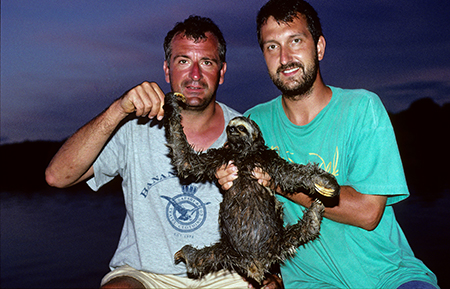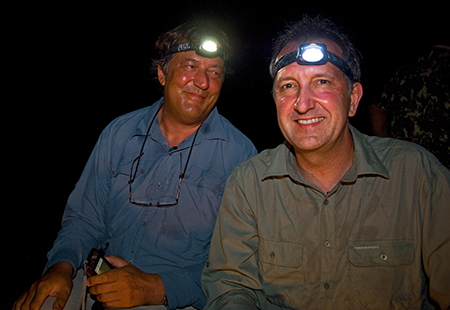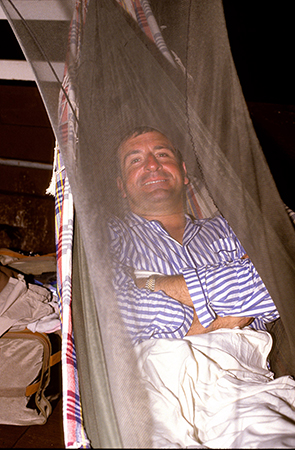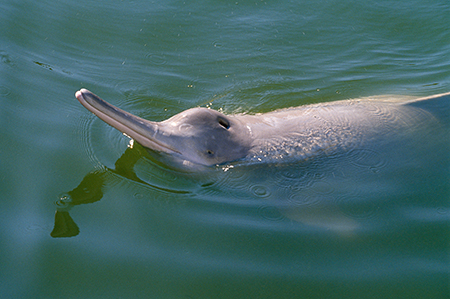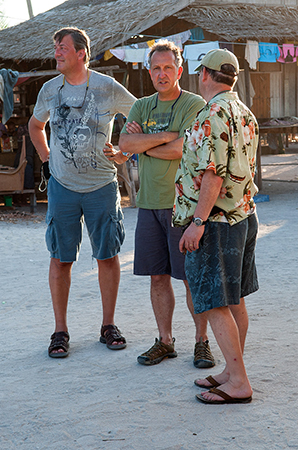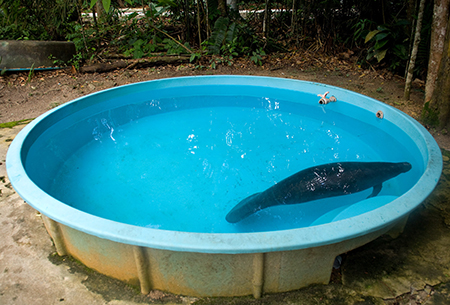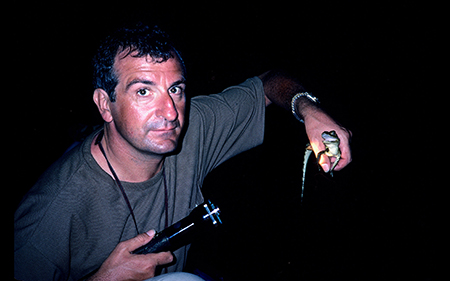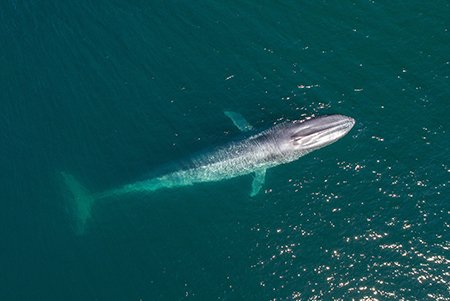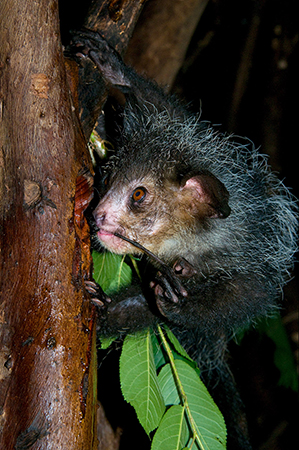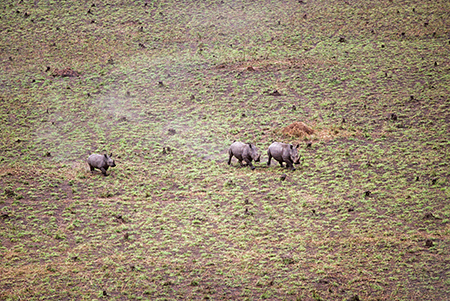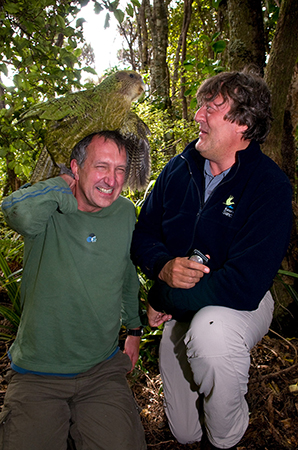

A 20-year project following Mark, Douglas Adams and Stephen Fry on two ground-breaking expeditions around the world in search of some of the weirdest, most remarkable and most troubled creatures on Earth.
Created to make conservation accessible to people who wouldn’t normally care about endangered species, Last Chance to See offers a uniquely hilarious but thought-provoking insight into the disappearing world around us. You can follow the unlikely trio on their travels – first in the late 1980s and then two decades later to see how all the animals had been faring – in a major BBC television series, a BBC Radio 4 series and two books.
From the steamy jungles of the Amazon to the ice-covered mountain tops of New Zealand, and from the edge of a war zone in Central Africa to a sub-tropical paradise in the North Pacific, Mark, Douglas and Stephen searched for a large, black, sleepy animal easily mistaken for an unusually listless mudbank, a parrot with a song like an unreleased collection of Pink Floyd studio outtakes, the most sexually confused bird in the world, a rhino with square lips, a dragon with deadly saliva, an animal roughly the length of a Boeing 737, the reincarnation of a princess, and the creature most likely to emerge from the cargo doors of a spaceship.
A large, greenish-brown bird, weighing up to 2.5 kilos, the kakapo is a nocturnal parrot. It is found only in New Zealand and, like many other island birds, has lost the ability to fly. Its future is looking increasingly bleak.
The kakapo, the old night parrot of New Zealand, is a bird out of time. If you peer into its large, round, greeny-brown face, it has a look of serenely innocent incomprehension that makes you want to hug it and tell it that everything will be all right, though you know it probably will not be. It is an extremely fat bird and flying is completely out of the question. Sadly, however, it seems that not only has the kakapo forgotten how to fly, but it has also forgotten that it has forgotten how to fly. Apparently, a seriously worried kakapo will sometimes run up a tree and jump out of it, whereupon it flies like a brick and lands in a graceless heap on the ground.
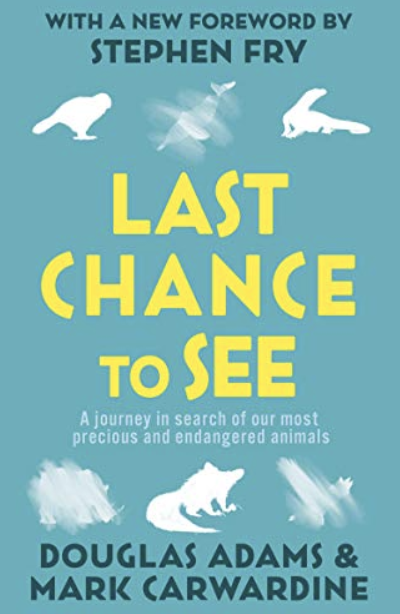
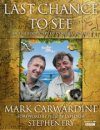


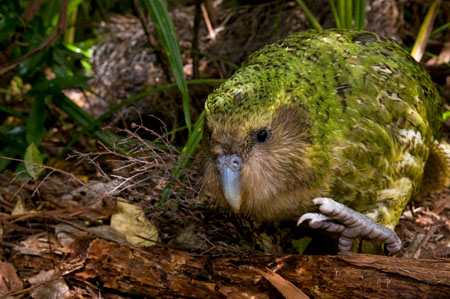
The world’s largest, fattest and least-able-to-fly parrot. Found only in New Zealand, it is as affectionate as a dog and as playful as a kitten, can inflate itself with air to become the size and shape of a football, smells like a musty clarinet case, and only comes out at night. The male’s song consists of a body-trembling, reverberating boom, rather like a heartbeat. It carries over huge distances but is so incredibly deep that it’s really hard to tell where it is coming from – which must be something of a shortcoming in a mating call.
Population on the first journey in 1988/89: 40
Surviving population on the return journey in 2008/09: 82
Main threats: originally, hunting for food, feathers and to provide museum specimens; then introduced predators such as rats, cats and possums; and also, with such a small population, egg fertility is abnormally low and there is a risk of genetic inbreeding.
Latest news: The current population of kakapo is 241 (2025). In 2010, the New Zealand Department of Conservation made Sirocco – the kakapo who famously mated with Mark's head – official Spokesbird for conservation. During 2016, he went missing (his transmitter failed) and he celebrated his 20th birthday, on 23 March 2017, quite happily alone and completely oblivious to all the fuss he’d caused. He turned up fit and well in February 2018 and has been fitted with a new transmitter.

Once upon a time, a few million years ago, there was a rhino that split in two. It didn’t split like an amoeba, of course, literally tearing itself in half and wandering off in two different directions. It split in the evolutionary sense. The two rhinos eventually grew into separate sub-species. One became the northern white rhino (speak quickly and you’ll say ‘northern right wino’ – at least you will now that it’s been pointed out) and the other became the southern white rhino. One thing you’ll notice about both of them is that they’re not actually white. They are more of a dull grey-brown colour. Despite what you might think, this isn’t because zoologists are either colour-blind or stupid. It’s because they are illiterate. It comes from a mistranslation of the Dutch word ‘wijde’, which means ‘wide’ and refers the the rhino’s mouth. This was misread as the Afrikaans word ‘wit’, which means ‘white’. And so the wide-mouthed rhino became the white rhino.
Population on the first journey in 1988/89: 22 in the wild (plus a small number in captivity)
Surviving population on the return journey in 2008/09: 8 (all in captivity – two in San Diego and six in Dvur Kralove Zoo, in the Czech Republic)
Main threats: originally poaching (exacerbated by political instability), now sheer lack of numbers.
Latest news: Northern white rhinos are extinct in the wild. In 2010, Mark and Stephen Fry made a one-hour BBC-TV special, following the translocation of four animals from Dvur Kralove Zoo, in the Czech Republic, to Ol Pejeta Conservancy, Kenya. Under the round-the-clock protection of heavily armed guards, it was hoped that they might be tempted to breed if they were back on African soil. But, sadly, that didn’t happen. One of the males, Suni, died in October 2014 and Sudan, the surviving male, died in March 2018, leaving two elderly females (Najin and her daughter Fatu). The two individuals in San Diego Zoo, meanwhile – Angalifu and Nola – died in 2014 and 2015 respectively.
In December 2021, egg cells were harvested from Fatu and flown to a lab in Italy where they were combined with frozen sperm from Suni. Two of the fertilised eggs were deemed viable, and there are now 30 embryos – stored in liquid nitrogen at -196C in Berlin, Germany and Cremona, Italy; the plan is for an embryo to be carried to term by a surrogate southern white rhino mother.

Once revered as the ‘Goddess of the Yangtze’, the Yangtze river dolphin or baiji was believed to be the reincarnation of a princess who had refused to marry a man she did not love and, for shaming the family, was drowned by her father. A beautiful bluish-grey dolphin, it had a low, triangular dorsal fin, broad flippers and a long, narrow, slightly upturned beak. It also had remarkably tiny eyes. It still has a phenomenally high profile in China – it’s the aquatic equivalent of the giant panda – and there is Baiji beer, Baiji cola, a Baiji Hotel, Baiji weighing scales, Baiji fertiliser and even Lipotes vexillifer toilet paper (in case you’re wondering, Lipotes vexillifer is the dolphin’s scientific name). But it never really stood a chance.
Population on the first journey in 1988/89: fewer than 100
Surviving population on the return journey in 2008/09: none (it has been presumed extinct since 2007)
Main threats: everything imaginable from agricultural run-off, noise pollution and riverbank development to heavy boat traffic, hunting and entanglement in fishing gear. The construction of the Three Gorges Dam was the final nail in its coffin.
Latest news: The last authenticated sightings were of a stranded pregnant female in 2001, and a live animal photographed in 2002. There was an intensive visual and acoustic survey – a final search for survivors – from 6 Nov to 13 Dec 2006, using two vessels operating independently and covering the entire historical range; they failed to find any evidence of dolphins. Occasional ‘sightings’ are reported in the press, but their validity is highly suspect (they usually turn out to be finless porpoises, which still live in the Yangtze River). There are none in captivity.

One of the first things Mark learned in science at school was this: if it stinks, it’s chemistry; if it doesn’t work, it’s physics; and if it’s green or wriggles, it’s biology. Using the same basic principle, if it’s almost as long as a Boeing 737 and lives in the sea, it’s a blue whale. Or a submarine, of course, but that misses the point. Blue whales are stupendously, astonishingly, breathtakingly, bloody enormous. Almost every aspect of them provides another superlative: they have the largest appetites on the planet (yet, in relation to body size, eat the smallest prey), have the smelliest droppings of any animal (that’s a bit subjective – but based on quite a bit of personal experience with blue whale droppings), and make the loudest sounds emitted by any living source. Oh, and they really are blue.
Population on the first journey in 1988/89: possibly fewer than 10,000
Surviving population on the return journey in 2008/09: possibly fewer than 10,000
Main threats: historically, whaling; nowadays, chemical and noise pollution, overfishing of prey species, entanglement in fishing gear, ship strikes and the challenges of a small surviving population.
Latest news: between 10,000-25,000 (2024); some blue whale populations are showing slow signs of recovery – particularly the one in the eastern North Pacific – but others may never recover from the ravages of whaling.

The animals living on Komodo can be divided into three main categories: highly venomous, mildly venomous and large, scary and drooling. OK, that’s a bit of an exaggeration – but the island does have a reputation for having more venomous snakes per square metre than anywhere else on the planet. And it is home to the largest and most dangerous lizard in the world. The Komodo dragon is, admittedly, an acquired taste – it has a mouthful of fetid saliva containing a witch’s brew of 57 strains of bacteria, and recent research suggests that is also has a venomous bite. Though it doesn’t actually breathe fire, it does have ‘the worst breath of any creature known to man’ (to quote Douglas Adams). You can’t even say that at least a Komodo dragon’s mother would love a Komodo dragon, because even that isn’t true: a baby dragon is just food as far as Mum (or any other adult) is concerned; it moves about and has a bit of meat on it, so it’s edible.
Population on the first journey in 1988/89: very rough estimate 3,000-5,000
Surviving population on the return journey in 2008/09: very rough estimate 3,000-5,000 (including some 1,400 on Komodo itself)
Main threats: its limited range makes it highly susceptible to storms, fire and disease; illegal trophy hunting and habitat loss.
Latest news: A count, published in 2021, estimated a total population of 3,458 individuals, including adults and juveniles. Two-thirds of these occur on Komodo and Rinca Islands, with smaller populations on Padar, Flores Island, Gili Motang Island and Nusa Kode Island (Jessop et al. 2021).

If a spaceship were to land on Earth, the creature most likely to emerge from its cargo doors is an aye-aye. It looks as if it’s been assembled from bits of other animals. It has a sort of cat’s body, a bat’s ears, a beaver’s teeth, a long busy tail like that of a squirrel on steroids, and enormous, bright yellow-orange eyes even more beady than those of E.T.. In other words, if you tried to turn a bat into a cat you’d probably end up with an aye-aye. Best of all, it has a skeletally thin middle finger rather like a long dead twig which looks like a contraption for zapping creatures from other planets (it’s actually used in ‘percussive foraging’ and, with the delicacy and precision of a surgeon’s probe, to extract juicy grubs from inside branches and tree trunks). This unlikely nocturnal lemur lives in Magagascar.
Population on the first journey in 1985: at the time, there were believed to be no more than a dozen survivors; however, while no one knew it at the time, they still had a few secret hideaways and weren’t quite so rare after all – just very good at hiding.
Surviving population on the return journey in 2008/09: unknown, but certainly in decline; there are about 50 in captivity around the world.
Main threats: critical habitat loss, hunting and persecution (there is a widespread belief that aye-ayes bring bad luck).
Latest news: What is left of Madagascar’s rich and diverse forests is disappearing frighteningly fast, being chopped and burned down to provide more elbow room for agriculture. In the two-decade gap between expeditions, the country’s human population doubled from roughly ten million to more than 20 million (in 2024, it's just over 30 million) – and that means yet more pressure on the country’s natural resources.

Originally described as a cross between a seal and a hippo (though not related to either) the Amazonian manatee is not so much like a seal as like a travelling case for carrying a seal in. An outlandish creature, it has a wonderfully carefree rotund body, predominantly black skin the texture of vinyl, a bright pink belly and diamond-shaped tail, a cleft lip, a reputation for farting more than any other animal on the planet, and an affinity for remote corners of tropical rainforest rarely penetrated by humans. In the old days, when men were men and manatees were much more common, sailors used to confuse them with mermaids.
Population on the first journey in 1988/89: rough estimate 8,000-30,000
Surviving population on the return journey in 2008/09: rough estimate still 8,000-30,000, but there is now strong evidence that numbers are decreasing
Main threats: hunting, as well as entanglement in fishing gear, riverine pollution and rainforest destruction.
Latest news: Hunting remains the greatest problem and continues throughout much of the manatee’s range – even within reserves. The murky waters make it hard to estimate the population, but the species is believed to be in decline.

The Mauritius kestrel was once regarded as the rarest bird in the world. In 1974, there were just four individuals left in the wild. But intensive conservation efforts – including captive breeding and release – have saved the species from extinction. The brilliant Carl Jones was originally sent to Madagascar to close down the Mauritius kestrel project (on the basis that it was throwing good money after bad) and, thank goodness, he brilliantly and spectacularly failed to do so. Instead, he set up a captive breeding programme and – somehow - discovered that if he walked into the cage of a captive male, wearing a bowler hat, the bird would mate with his hat. Carl was able to collect the semen and use it to inseminate one of the last surviving females. And so he brought the species back from the rim…
Population on the first journey in 1988/89: approximately 200 birds in the wild
Surviving population on the return journey in 2008/09: approximately 500-600 birds in the wild (including 85-100 breeding pairs)
Main threats: originally, deforestation; more recently, pesticide-use, introduced predators such as rats, cats and crab-eating macaques, and introduced plants (which have changed its habitat and affected it’s hunting proficiency); with such a small population, it also suffers from a lack of genetic variation due to inbreeding.
Latest news: Numbers in the wild are decreasing – possibly because of inbreeding – and the current estimate is down to around 350 individuals (2021). It was declared Mauritius's national bird in March 2022.
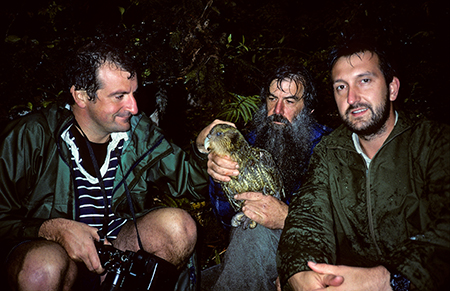
‘The best thing I’ve ever done was to travel around the world with my zoologist friend, Mark Carwardine, to look for various rare and endangered species of animal. The book about our travels, called Last Chance to See, is my personal favourite.’
Douglas Adams (on the left) author of
The Hitchhiker’s Guide to the Galaxy
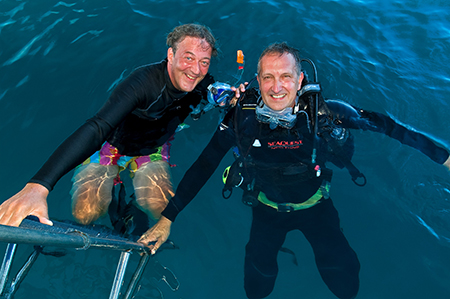
‘Mark Carwardine will climb mountains, ford streams and penetrate steamy malaria-infested swamps just for one glimpse of an animal. Not only that, but he will encourage, belabour and enthuse any large, sweaty, unwilling companion who happens to be lumbering at his side wishing there were better phone signals and air-conditioning available.’
Stephen Fry, actor and comedian
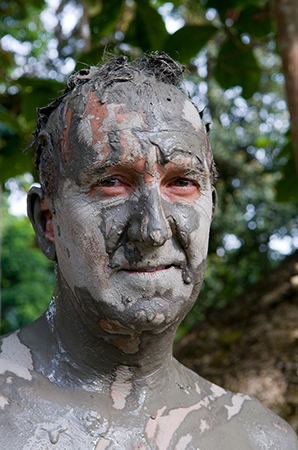
‘The scariest thing about Last Chance to See is that, out of the eight endangered species we searched for, one became extinct during the 20-year project and another dwindled
to just a handful of survivors barely clinging on in captivity. It really brought home just how rapidly we are losing so much of our wildlife.’
Mark Carwardine
